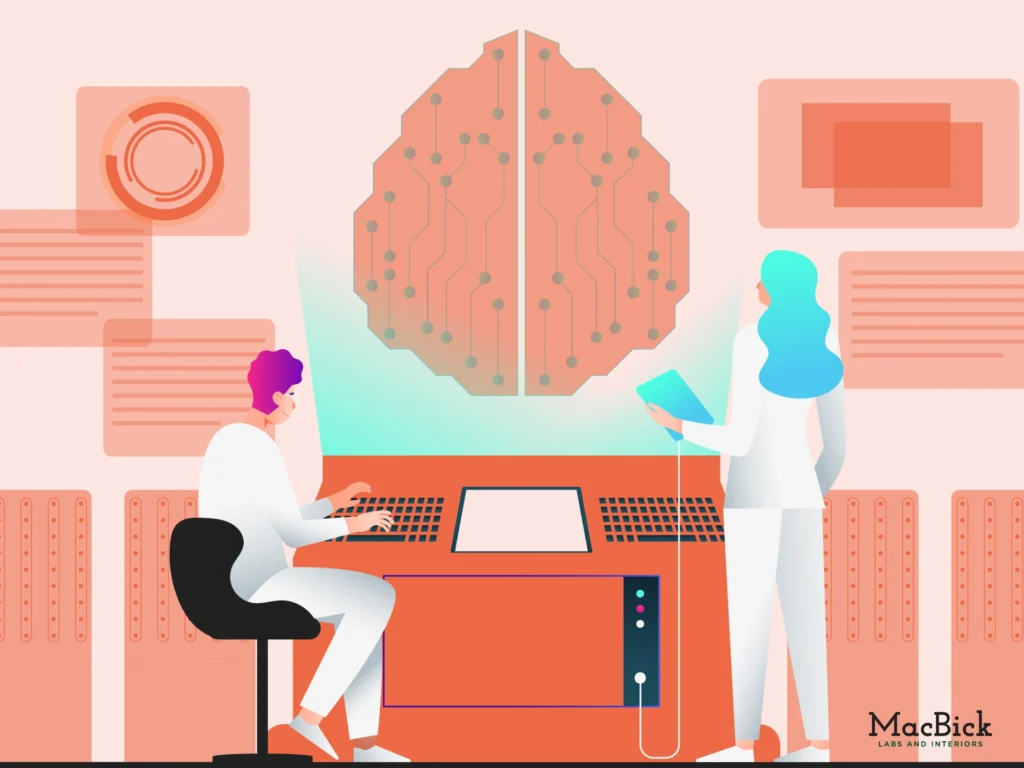“Artificial intelligence is not a substitute for human intelligence; it is a tool to amplify human creativity and ingenuity.” – Fei-Fei Li”
The ascent of artificial intelligence has been nothing short of remarkable. With the promise of increased productivity, faster procedures, and revolutionary discoveries, artificial intelligence (AI) has surged to the forefront of modern scientific endeavors. However, in the midst of this technological revolution, our design philosophy must never forget what it is to be human.
This is a conversation on maintaining human-centered lab design while integrating AI in a nuanced way. Let us first take a moment to consider the importance of preserving a human touch in the face of increasing automation.
The Rise of Artificial Intelligence in Lab Design
Former strongholds of human labor and painstaking craftsmanship, laboratories are currently undergoing a radical transition towards automation and artificial intelligence integration. With its unparalleled productivity and efficiency, artificial intelligence (AI) has permeated every aspect of research, from precision instruments to data processing algorithms.
However, we cannot undervalue the inherent value of human intuition and creativity in the laboratory amidst our fervor for technical growth. After all, the human mind is the one that formulates novel theories, plans complex experiments, and deciphers the subtleties of scientific findings.
Understanding AI Integration in Lab Design
There is no denying AI’s contribution in lab settings. It can speed up routine activities and reveal hidden patterns in large datasets, among many other advantages. Among the real benefits that artificial intelligence (AI) offers are increased productivity, adeptness in data processing, and task automation.
In any case, similar to each disruptive technology, there are issues and troubles that accompany it that should be solved. The over-dependence on artificial intelligence represents a serious danger to the human component that is fundamental for logical progression. Furthermore, the goal for AI integration necessitates careful consideration of ethical issues pertaining to algorithmic openness, bias reduction, and data privacy.
The Essence of User-Centric Lab Design
The creation of intuitive and user-friendly laboratory facilities must be given top priority if we are to successfully address some of the implementation issues for AI. The following three fundamental ideas guide user-centric design practices:
- Understanding User Needs and Behaviors: The workflow and experience of the user should come first in design.
- Incorporating Feedback Loops: Loops for continuous feedback make sure that the design changes over time to accommodate user needs.
- Prioritizing User Experience: The user’s experience and productivity should be improved in every way by the design of the lab.
Strategies for Balancing AI Integration and User-Centric Design
A more nuanced approach is required to achieve harmony between AI integration and user-centric design. Following are few strategies that that you can implement in order to harmonize AI integration and User-Centric Design:
Cultivating a Human-AI Partnership:
- Complementary roles of humans and AI: Both humans and machines bring unique strengths to laboratory environments. It’s important to recognize where each excels and collaborate accordingly.
- Collaborative decision-making processes: When using AI tools, human input should still play a prominent role in analyzing findings, making diagnoses, and drawing conclusions.
Integrating User Feedback Into AI Systems:
- Continuous improvement cycles: At each degree of advancement, feedback mechanisms ought to be set up to assist artificial intelligence applications with being improved and enhanced depending upon user needs.
- User-centric AI training: To avoid biases or errors, AI models should be trained on a variety of datasets that are representative of real-world situations.
Designing Flexible Systems:
- Adaptable workflows: The ability to customize lab layouts and configurations according to specific projects or priorities can enhance efficiency and flexibility.
- Scalable infrastructure: Investment in scalable hardware and software resources allows labs to adapt rapidly to evolving demands and technological advances.
Prioritizing Ethical and Humanitarian Considerations:
- Ensuring fairness and transparency: Preventing inequities and fostering user trust requires accurate reporting of AI capabilities and equal access to the technology.
- Mitigating bias and discrimination: Making sure AI systems are created and used equitably across all ethnicities and demographics requires careful thought.
Examples of User-Centric Lab Design
Ergonomic Workstations: Modern laboratory facilities employ ergonomic chairs, desks, and computer screens designed explicitly to support prolonged periods of sedentary activity. The aim is to minimize physical strain and alleviate discomfort caused by long bouts of seated work. Examples of such workstation setups include height-adjustable tables, comfortable armrests, and anti-fatigue mats placed beneath footwear.
Robot Assisted Techniques: Robotic platforms can be utilized in different ways, including material transport and preparation, and sample testing. Automated solutions like liquid handlers, plate sealing robots, and centrifuges can save considerable time when used appropriately. For example, robotic arms can rapidly distribute small quantities of liquids across multiple plates simultaneously, speeding up assay setup times drastically.
Virtual & Augmented Reality Tools: Virtual and augmented reality simulations can help train personnel before exposing them to live, operational scenarios. VR simulations allow trainees to practice techniques in controlled conditions, minimizing the risk of accidents or errors. AR overlays can provide real-time guidance and instruction, guiding operators step-by-step through complex protocols.
Future Directions and Challenges
Looking ahead, there are possibilities as well as obstacles in the rapidly changing fields of AI and lab design. While new technologies have the potential to open up new areas of study, it is nevertheless difficult to navigate the moral and societal ramifications of these developments.
Conclusion
It is evident that the human component is crucial when considering the junction of AI integration and user-centric lab design. We can use AI to improve our capacities and advance science by adopting a comprehensive strategy that prioritizes human creativity, intelligence, and empathy. Let’s answer the call to action for a well-balanced integration of AI in lab design and approach this endeavor with hope and forward-thinking.
To efficiently integrate AI into your User-Centric lab design, contact Macbick Labs and interiors for expert assistance today.


